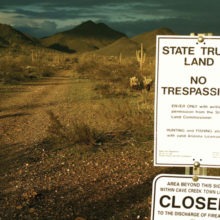- Some states have advocated transferring federal lands to states, pointing to state trust lands as evidence that states would better manage federal lands for revenue.
- States would increase revenue by more aggressively developing and leasing transferred lands for commercial activities and by charging higher fees and royalties to industry.
- The public would be charged to access transferred lands. The public would lose access to some transferred lands leased to commercial activities.
- Rural economies would become more exposed to boom and bust market dynamics and to policy changes outside state and local control.
State Trust Lands in Transition
This report is in a four-part series seeking to better understand state trust lands in the western economy and landscape. The series includes:
- Understanding the Trust Model
- Permanent Funds
- Challenges from New Uses and Demands
- Implications for Federal Land Transfer
Several western states and local governments have advocated for the transfer of federal public lands to states, arguing that states would be better managers. The income generated from development and commercial use of state trust lands is often cited as evidence for this argument. To understand the fiscal and economic implications of federal transfer, we looked closely at how trust lands are currently managed by states.
State trust lands are managed under a unique fiduciary trust relationship that requires states maximize revenue for public beneficiaries, primarily schools. The trust mandate also requires states to maintain the value of the whole trust in perpetuity. States transfer income from the sale of trust assets—land and nonrenewable resources such as oil and gas, coal, and minerals—to a permanent fund. In comparison, U.S. Forest Service and Bureau of Land Management lands are leased for commercial activities but are managed for multiple uses, including public access, ecosystem health, cultural and historic values, and more. Federal agencies have no obligation to save nonrenewable revenue.
Implications of Federal Land Transfer
We find several important implications of transferring federal land to states for management as trust lands. First, state trust land managers do, indeed, generate more revenue than federal land managers. They charge higher rates and get more money for a wider range of land sales, land development, and commercial natural resource activities. Additionally, they save nonrenewable resource revenue in a permanent fund, helping to endow assets for public institutions.
However, we also find significant downsides to federal land transfer. State trust lands exist in a political environment and are subject to lobbying and political pressure. State trust lands are exposed to capture by industry and rent-seeking behavior by lessees, who can also exclude other uses such as public recreation. This is generally achieved when lessees exert political pressure to secure preferential leasing (avoid competition) or lobby to maintain below-market rates and other favorable lease terms.
Further, the argument that states do better because they generate net revenue is not the whole picture. The expenses for many activities on state land—such as wildfire suppression and endangered species management—are actually paid by other state agencies. A lot of costs associated with federal management would be transferred to the states, for example, the Payment-In-Lieu of Taxes program.
Finally, if lands are transferred, rural communities that remain reliant on natural resources could become more specialized and be subject to increased volatility and dependence. Communities working to transition away from resource-dependence and toward recreation or other amenity-based activities also could suffer because transferred lands would no longer be managed for those uses.
Specific impacts are described further below and in the full report.
Effects on Land Use
Because the primary purpose of state trust lands is to generate income for beneficiaries, states would:
- Increase royalties and fees for lessee activities, including grazing, oil and gas, coal, timber harvest, and other commercial uses.
- More aggressively manage lands and make more lands available for extractive uses.
- Develop lands whose commercial value exceeded their natural resource leasing value.
- Sell lands where the financial returns of investing the value in financial investments (the stock market, for example) exceed the returns from renewable land management activities (such as grazing).
States would also move to reduce costs in order to generate income for beneficiaries. To do this they would:
- Eliminate funding for recreational infrastructure because recreational fees generate negligible revenue.
- Reduce recreational land access.
- Eliminate funding for conservation, such as wildlife habitat, aesthetic values, ecological functions, or cultural and historic values.
Increased State Government Expenses
The transfer of federal lands to states would impose new costs on states. It is unclear whether revenue from transferred lands would exceed new costs. These new costs would include:
- More than half a billion dollars that would have to be paid annually to state and local governments as compensation for the non-taxable status of the lands.
- Funding for a variety of programs on new state trust lands, such as wildfire suppression, rangeland monitoring, oil permitting, and environmental planning, which does not currently come from the trust lands budget.
- Increased expenses in providing benefits previously generated from ecosystem services—for example, treating municipal water.
- Spending for non-revenue-generating public values on state trust lands, which the public demands and states are already funding, despite it being outside the trust mandate. This pressure is likely to continue and intensify in the case of a land transfer.
Economies Become More Specialized and Volatile
Transferred federal lands will be managed exclusively and more intensively for extractive and renewable uses such as agriculture, timber, mining, and fossil fuel extraction. This will narrow and specialize surrounding economies, making communities less resilient and more exposed to boom-and-bust market dynamics. Results of this dynamic will include:
- Employment in extractive industries may initially rise, but will not reach historic levels because mechanization has reduced the need for human labor.
- State and local governments would become more dependent on natural resource revenue and more susceptible to major budget shortfalls during bust years.
- State governments would be incentivized to sell their increased land holdings to fill gaps during bust years.
- State governments, if they continue to follow the permanent fund savings model, would have a stable source of income. However, they already face pressure to spend the permanent fund, and are unlikely to be able to afford management of federal lands while also saving nonrenewable resource revenue.
- Economies that have diversified beyond traditional land uses and depend on the public values of federal land for economic development will suffer.
State Trust Lands in Transition
This report is in a four-part series seeking to better understand state trust lands in the western economy and landscape. The series includes:
- Understanding the Trust Model
- Permanent Funds
- Challenges from New Uses and Demands
- Implications for Federal Land Transfer
Series Contributors

Mark Haggerty
Mark is a Researcher and Policy Analyst with Headwaters Economics.

Chelsea Lidell
Chelsea was a 2019 Public Lands Fellow at Headwaters Economics.
Cover photo of state trust land sign courtesy Tom Lane – High Country News.


